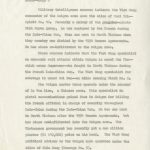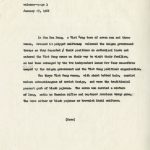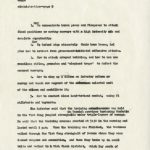1966, January 18, “The Red Noose”
Deepe
Noose–page 1 VC. Strength- Sgn.
January 18, 1966
Saigon–The Red Noose–a Communist stranglehold–is tightening around this nervous capital city.
TheseIntelligence sources indicate that the Viet Cong Communists plan to utilize what they described as the “tactics of Mao Tse-Tung plus those of Lenin” in their long-range battle plan for Saigon. This plan combines Mao Tse-Tung‘s tactics of using armed guerrillas to seize the villages and then to encircle Saigon plus the street-fighting and people’s uprising within the inter-ring of Saigon city, similar to the way in which the Communists seized power in the 1917 revolution in Russia.
Military intelligence sources also indicate that the equivalent of a battalion of Viet Cong–organized into suicide squads, and murder teams, and sabotage commando units–have already penetrated within the city limits of Saigon, ready to strike when the Communist command orders are received.
Deepe
noose–page 2
Outside of Saigon, the Viet Cong have established a double ring of regular forces, organized under two regimental co-ordinating commands. The one regiment, Called the “Capital Regiment Headquarters”, comprised of three regular “light” battalions, is known to operate close to Saigon within Gia Dinh province. The second regiment, comprised of four regular “light” battalions, oper ate in a larger circle surrounding the area of responsibility of the Capital Regimental Headquarters,. an eighth Battalion is currently under training and will completebring the capital regiments up to full strengthfour battalions.
In short, the Viet Cong have Saigon doubly encircled with two separate rings of troops. these intelligence sources report the Communists late last year established the two regimental coordinating commands for Saigon—Cholon—Gia Dinh. On December 13, 1965, at a special meeting, Viet Cong leaders for the capti capital region established and named one of the commands the “Capital Regiment Headquarters.” The name of the second regiment is currently unknown, according to intelligence sources. The Capital Regiment Headquarters has under it‘s control three batta only three “light” battalions: the 3rd Battalion situated northeast of Saigon, the 4th Battalion Southeast of Saigon the 6th Battalion southeast of Saigon. The 5th Battalion is under training–to be completed next month–and is to be assigned northwest of Saigon, according to military intelligence sources.
Deepe
noose–page 3
These seven “light” battalions controlled by the two regimental headquarters each have fuor four companies of roughly 150 men per company, or roughly 600 men per battalion–which is numerically stronger than a Vietnamese government regular Army battalion.
These seven Viet Cong “light” battalions are considered to be hard-core regulars, recruited in their local villages and provinces. They operate in addition to the local village and regional guerrillas–part-time farmers and part-time fighters.
During a seven-day, 8,000-man operation from Jan. 8-15, American paratroopers and Australian troops cracked the main base area of the Viet Cong Saigon–Cholon–Gia Dinh Committee, killing 151, capturing 91, carrying off tons of documents and weapons, which were hidden in a complex honeycomb of tunnels, cement blockhouses and underground defenses. While the allied forces disrupted the headquarters, the Viet Cong are expencted to move back into the infamous Ho Bo woods area at a later time.
Deepe
noose–page 24
This week the noose around Saigon visibly grew tighter when, within a 20 hour period, in the doughnut province of Gia Dinh, which surrounds Saigon, an unknown number of Viet Cong placed small arms fire on a village ten miles southwest of Saigon,. (jan 16th) six hours later a Viet Cong company six miles southwest of Saigon mortared a Vietnamese airborne battalion which was stationed to protect one of the largest military oil depots and American and ammunition unloading bases in the capital area. The next day the Viet Cong simultaneously mortared and attacked the Thu Duc Infantry and Armored School, which is situated between Saigon and a division-plus of American combat forces in the Bien Hoa airbase area, only twelve minutes drive from Saigon.
During this last attack, Saigon generals, businessmen and peons fossedtossed in their beds as first the soft patter of Viet Cong machine gun fire was heard, then whomping reaction of the instant artillery–and seconds later the sharp whistle of American jets rushing to the battle area.
Deepe
noose–page 35
The Capital Military Region comprises Saigon and it’s Chinese twin-city of Cholon (total pop. ______1,641,000) covering 5030 square kilometersmiles, plus Gia Dinh province covering 77 square miles. American military commanders have classified Gia Dinh province as “pacified” but the number of Viet Cong armed attacks have steadily been rising within the province; district headquarters barely out of site of the neon lights of Saigon city are consistently mortared. Almost nightly now, Saigon diners from rooftop restaurants can witness flaredrops and jet|strafing rungs.
“Almost every night we drop flares right at the end of the big runway,” one American airman at Saigon‘s Tan Son Nhut airport explained. “We’ve got battalions of Viet Cong right around this airbase. We have firefights three times a week at the bomb dump right on the edge of the runway. Nobody goes down by that bomb dump unless he has to. American crew chiefs have to guard all-night their individual aircraft parked down near there–but they know they’re just sitting ducks.” American pilots often land at night at Tan Son Nhut without any lights on the plane because they feel they are less conspicuous targets for the Viet Cong snipers at the end of the runway.
Deepe
noose–page 6
Military intelligence sources indicate the Viet Cong commander of the Saigon area uses the alias of Muoi Tri–Spirit No. 10. Formerly a member of the gangster-pirate Binh Xuyen group, he was captured by the French during the Indo-China War, then was sent to North Vietnam when they country was divided by the 1954 Geneva Agreements. He has since re-infiltrated to the Saigon area.
These sources indicate that the Viet Cong specialist on commando raid attacks within Saigon is named Cao Pha which means Superman–who fought in North Vietnam during the French Indo-China War. The Viet Cong specialist for sabotage is named Hai Den–an alias meaning Black No. 2.
The Saigon murder teams operate under the command of La Van Lien, a Chinese name. This specialist in pistol assassinations gained fame in Saigon for killing the French official in charge of security throughout Indo-China during the Indo-China War. He too was sent to North Vietnam after the 1954 Geneva Agreements, but has since re-infiltrated into the Saigon area. The Vietnamese government has recently put a one million piastre (US $10,000) price on his head. The Viet Cong political advisor to the Saigon area operates under the alias of Chin Dung (Courage No. 9).
More American and foreign civilians have been killed in Saigon by sabotage and terrorism than in all other parts of Vietnam combined, according to reliable sources.
-30-
Welcome
Saigon Security
Though they fought fiercely and often without mercy, the Viet Cong made an effort to be welcoming to the Vietnamese populace. The following article details in part the approach the VC would take in recruiting others.
deepe
welcome–page 1
January 27, 1966 Saigon Security
PHU HOA DONG, SOUTH VIETNAM–On the outskirts of this sun-baked district capital only twenty miles north of Saigon, the Viet Cong Communist political cadre established teams of armed men and women to welcome Vietnamese government troopers into their zones.
In Than Phu Trung (New Central Richness), only 17 miles northwest of Saigon, the Viet Cong guerrillas showed military movies, held cutrual cultural singing and dancing entertainment, and then held a four-abreast military review of their troops under the battery-operated flood-lights, beneath the jungle canopy.
In Thu Duc , a suburban-like town only seven miles northeast of Saigon, Viet Cong political cadre visited house-by-house the families of Vietnamese government troops, urging them to defect from the Saigon government ranks.
(More)
deepe
welcome–page 2
January 27, 1966
These examples of armed propaganda and “proselytization”–as the Communists call it–flourishd openly on the outskirts of Saigon during the Lunary New Year ceasefire la st week–and then withered into invisible, underground, covert subversive operations during the remainder of the year.
(More)
deepe
welcome–page 3
January 27, 1966
In Phu Hoa Dong, a Viet Cong team of seven men and three women, dressed in polygot uniforms, welcomed the Saigon government troops as they departed p their positions on authorized leave and entered the Viet Cong zones on their way to visit their families, as had been arranged by the two independent Lunar New Year ceasefires ussyedissued by the Saigon government and the Viet Cong political organization.
The three Viet Cong women, with short bobbed hair, carried modern submachineguns of Soviet design, and wore the traditional peasant garb of black pajamas. The seven men carried a mixture of long, antiq ue Russian rifles and captured American tommy guns,. The wore either or black pajamas or brownish khaki uniforms.
(More)
deepe
welcome –page 4
January 27, 1966
Vietnamese government army regulars, reinforced by a M-21 tank squadron, are assigned to secureprotect Phu Hoa Dong, which was the pilot case project for the Jop Hop Tac planc to secure pecure vitw bits of the seven provinces surrounding Saigon. But, the Viet Cong welcoming teams–operating under the noses of the government trooo troops–illustrate the serious defects in the Hop Tap plan and the general insecurity of the region surrounding Saigon.
(More)
deepe
welcome–page 5
January 27, 1966
At a Vietna mese government checkpoint near Phu Hoa Dong–which means Rich Eastern Peace–a Vietnamese government regular soldier wept because the military police jerked him off the tri-wheeled mort motorized lambretta , seized his identity papers and assured him he would be reprimanded by his superiors.
“I’ve saved two months’ pay to give to my mother,” he sobbed, “but I can’t get home to give it to here. She lives in the Viet Cong zone.”
(M9re)
deepe
welcome–page 6
Janua ry 27, 1966
In Tan Phu Trung, only 17 miles northwest of Saigon, relia ble sources reported that during the Luna r New Year ceasefire, Viet Cong guerrillas and propa gandists visited the village and held a two-hour performance. The performance began with a shor t war mofvie showing Viet Cong guerrillas fighting in neighboring areas and this was followed by a theatre performance with the theme of personifying the heroic deeds of Viet Cong fighters. The theatre performance included Vietnamese songs, accompanied by mandolin and guitar, and Viet Cong “renovated” dances.
The highlight of the evening for the villagers, however, was a half-hour military review, in which Viet Cong troops marched four abreast, carrying individual and unit weapons such as light mortars and anti-tank weapons. They were dressed in mixed and uniforms of black pa jamas, brownish khakis, and green locally-made hats. A handful of women were included in the review, which was held under four battery-operated floodlights beneath a thin jungle canopy. Reliable sources said several families drove their cars up to village to see the performance, which was held only 200 yards from the main highway.
deepe
welcome–page 7
january 27, 1966
Reliable sources said that even Vietnamese government troops were invited to witness the performance–and several from a nearby post dressed in civilian clothes to attend the evening’s entertainment.
Other reliable sources indicated that the Viet Cong also showed war movies, illustrating Communis t heroism, only yk three kilometers from Ben Cat, a government district capital forty miles north of Saigon where elements of the U.S. Army 1st Infantry Division are based.
“Alot of Americans were killed and wounded in that movie,” one spectator reported.
deepe
welcome–page 8
In Thu Duc, seven miles from Saigon, Viet Cong propagandists visited the families of government troops, wh wished them a Happy Lunar New Year, chitchatted about the local situation and asked inquired about the sons serving in the Vietnamese Army.
“Alot of young people are fighting to liberate the country,” the Vita Viet Cong cadre told one family. “But your son is serving the enemy and the Americans. Maybe your son can not escape from the enomy armyenemy, or he can not escape the draft. But he should not shoot at the Viet Cong during a battle, a nd he should wait on the sidelines ready to h turn his weapon against the Americans and the Vietnamese puppet forces.”
deepe
welcome–page 9
January 27, 1966
South of Saigon, on the main Highway No. 4 leading to the Mekong Delta, the Viet Cong established two mined roadblocks obstructing all traffic from a six-kilometer chunk of no-man’s land. They then planted Viet Cong fla gs–Blue>green and red with a golden star— and “Happy Year of the Horse–the Year of Victory” slogans along the roadside. One Vietnamese government police jeep was blown up, and even with 30 government armored pos personnel carriers and tanks, but roadblocks were not removed for several hours.
During the Lunar New Year ceasefir e, the Viet Cong surfaced to implement the program they have reportedly given top priority for the remainder of the year; to agitate politically in the enemy rear–among government troops, along the government-controlled roa ds, cities and towns, while intensifying their frontline military offensives.
-30-
Administration
Saigon Security
The following article gives some insight into how the VC ranks are organized.
deepe
administration–page 1
Jan. 20, 1966 Sgn. Security
SAIGON–Military intelligence sources reported today that Viet Cong (Communist) political cadre are establishing subversive administrative councils in the villages on the outskirts of Sa igon.
These sources said that the administrative councils would had already been setup to govern these villages once the Communists seize power within South Vietnam. Within recent months, five of the anti-Communist village and hamlet chiefs have been assassinated only ten miles from the city limits of this capital city.
(More)
deepe
administration–page 2
Jan. 20, 1966
North Vietnamese regu refugees, who watched the Communists reinforcemenar defeat the French during the French Indo-China War twelve years ago, recalled that the Communists had established similar administration councils within the capital city of Hanoi in 1951–three years e before they defex became the government. In 1951, These administrative councils had mapped out and organized the future intention Communist Party policy on the most detailed problems of governing the city–including the disposal of garbage and sewage.
(More)
deepe
administration–age 23
Other intelligence sources reported that the Viet Cong are recruiting guerrillas from within the city of Saigon, and it’s Chinese twin city of Cholon, as well as from the villages on the outskirtsof Saigon–which the government Vietnam American-backed Vietnamese government describe as “pacified.”
Included in the c recruitment of guerrillas as thix Vietnamese-boix born Chinese, who are now participating on the side of the Viet Cong. Some Chinese Communist influence is considered to penetrate the half-million political atmosphere of Cholon, the Chinese populated twin-city of Saigon containing roughly half-million people. During recent weeks, two staunchily anti-Communist Chinese businessmen and one teacher[propagandist?] have been assassinated. Recently, a motorcycle equipped with loudspeaker raced through the streets of Cholon broadcasting Communist propaganda . Reliable sources indicated that the motorcycle driver was Chinese origin.
(More)
deepe
administration–page 4
Military sources indicated thatmm reported that V the Viet Cong maintain seven “light” battalions–totalling more than 4000 men–in the outskirts of Saigon, and have also organized the equivalent of at least one battalion of assassination squads, commando units and suicide teams within the city limits of Saigon. An eighth battalion outside of Saigon is to be graduated in late February, according to intelligence sources.
One defs
A Viet Cong defector from one of these seven “light” battalions described his recruitment, training with the Viet Cong.mm organized guerrilla fighters.
(More)
deepe
administration–page 5
The defector told the New York Herald Tribune that the battalion commander and the deputy battalion commander of his unit–the 6th battalion operating in the outskirts of Saigon–was a native born South Vietnamese, but had returned to North Vietnam when the country was divided by the Geneva Convention in 1954. The commander had since infiltrated back to the South. The deputy battalion commander was
However, the political commisar commissar of the unit “was “is a new man that has just come in from North Vietnam–and is North Vietnamese by birth,” according to the defector. He said that 9 ninety per cent of the troops in his unit had been recruited from their local villages outside of Saigon–but that the recruitment had accelerated since the February airstrikes against North Vietnam.
(More)
deepe
administration–page 6
The defector said that the Viet Cong recruti recruiting agent — called propaganda and proselytizing cadre–told him that if thayxx he joined “the puppet government forces” he would have to kill more of thexmhis friends and reliatives in other villages a nd that since he had little education “he wo “i “I would have little future with the government and American forces,.”
“If you join the Viet Cong you don’t have to kill innocent people and your future will be very bright,” the defector said he had been o told by the recruiting agents. “Weh “When we win the war, you will become master of the country.”
(More)
deepe
administration–page 7
The defector said that he had been given 11 weeksmonths of training with the Viet Cong before he became a full-time guerrilla. “The first three months we movex studied in the villages around Saigon,” he explained. “About 80 per cent of the study was on political training–including some cultural training like teaching the illiterate people to read. Only twenty percent of the g training dealt with guerrilla warfare,“ which included how to lay boobytraps a nd spikes and how to shoot pistols and rifles.”
He said that the trainees then were given four months of “district level” training further from Saigon, where sixty per cent of the instruction dealt with political-cultural subjects, including how to M make Viet Cong propaganda and how to become friends with the local people.
(More)
deepe
indie administration–page 8
At the di “district level” the trainees were given about spent about forty percent of their instruction time on military training,o involving more sophisticated weapons such as .30 cal. machineguns, automatic rifles.and bxommdom They were also taught how to camouflage themselves well.
The trainees were then sent to four more months of “zone-level” instruction, which was the highest and most sophisticated quality of instruction. However, about sixty percent of their time was devoted to military instruction, while only forty percent dealt with political subjects.
On the political front, they were taught the political policies of the National Liberation Front for South Vietnam (the political backbone of the Viet Cong guerrillas–which is dominated and directed by the Communist People’s Revolutionary Party.)
During their military instruction, the defector said that therix he was taught to conx five main tactics:
(More)
deepe
administration–page 9
1. How To concentrate human power and firepower to attack fixed positions or moving convoys with x high intensity of and complete superiority.
2. How To defend adqe adequately their home bases inl plus how to retreat from government-initiated offensive attacks.
3. How to attack armored vehicles, and how to use use recoiless rifles, grenades and “elephant traps” to defeat the armored convoys.
4. How to chop up a column an infantry column or convoy and smash one segment of the column.mm selected unit of the column and annhiliate it.
5. How to conduct close hand-to-hand combat, using fi rifelbutts and bayonets.
The defector said that the training school some was held in the Viet Cong jungled strongholds in Tayninh province bordering Cambodia under triple-layers of canopy. He said that the training courses started at 5:30 in the morning and lasted until 4 p.m. When the training was finished, the trainees walked through the Viet Cong stronghold of D-Zone where they were issued weapons and ammunition, and then they broke up in small units and walked to b Binh Chanh district, which lay south of Saigon-Cholon on the outskirts of the city.
deepe
administration–page 10
During their march to Binh Chanh, the defector said, that the unit moved during the daytime in the thick jungle, but moved at night through areas containing government outposts.
“Everytime we stopped we had to dig foxholes,” the defector said. “Most of these stops were made 2-3 kilometers from the villages where the people lived. Even if we were near our home village, we could not go to see our relatives. We were forbidden even to talk with our wives.”
Read Next Article: 1966, March 17, “Hold Free Elections in Vietnam”

























